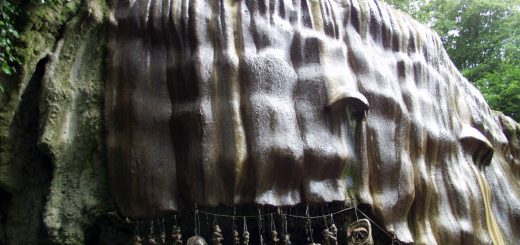Filey Brigg
Filey Brigg is a long ridge of rocks jutting into the North Sea, associated with folklore concerning the Devil and a dragon.
The Devil dropped his hammer into the sea whilst making the ridge, and thus he plunged his hand into the water to retrieve it. When he pulled his hand out, he had not grabbed his hammer but a fish. Shouting out “Ha, Dick” the Haddock got its name. This story is supposed to explain the distinctive markings on all haddocks, as the location where the Devil held the fish.
 Another story concerns a dragon, which had been tricked into eating a large quantity of parkin: the sticky cake got stuck to its teeth so it went to the sea to wash them. At this point the locals ambushed the dragon and drowned it. Therefore it was also thought that Filey Brigg was the fossilised bones of this local dragon.
Another story concerns a dragon, which had been tricked into eating a large quantity of parkin: the sticky cake got stuck to its teeth so it went to the sea to wash them. At this point the locals ambushed the dragon and drowned it. Therefore it was also thought that Filey Brigg was the fossilised bones of this local dragon.
On a stranger note there have been reports of a sea monster off the Brigg. The most notable was by coastguard Wilkinson Herbert on February 28th 1934. He witnessed a thirty foot creature just off shore: “…Suddenly I heard a growling like a dozen dogs ahead. Walking nearer I switched on my torch, and was confronted by a huge neck, six yards ahead of me, rearing up three feet high! The head was a startling sight, – huge tortoise eyes glaring at me like saucers. The creature’s mouth would be a foot wide and the creature’s neck would be a yard around.” Perhaps a relative of the local dragon.
Directions: Reached via a footpath from Filey. Filey is off the A165 to the South of Scarborough.




Re: Filey Brigg
Rev. Parkinson in Yorkshire Legends and Traditions (1888) describes the legend of the Devil marking the Haddock at Filey Brigg and mentions other legends associated with how the fish got it’s distinctive pattern.
‘The two dark marks on the shoulders of the haddock are by the legends of many lands, attributed to the Evil One; though by another legend the fish is said to have been the one caught by St Peter, at his Divine Master’s command, in the Sea of Galilee, and the marks to have been those of the apostle’s finger and thumb made in holding the fish while he extracted the piece of money for the tribute from its mouth. The Yorkshire legend, however, brings the origin of the marks nearer home. According to it, the Devil was the builder of the well-known dangerous ridge of rocks known as Filey Brigg. As he was proceeding with this work, he, by chance, dropped his hammer into the water. Diving, in haste to recover it, he by mistake seized a haddock instead of the hammer. Since then the whole species has borne upon its sides the marks of the infernal hand, and shall so bear them to the end of time. ‘
Re: Filey Brigg
There is tradition th Filey Brigg was constructed by the Devil, with the express purpose of killing mariners.
Another tradition says that the Devil was trying to build a bridge across the North Sea, but the length of the reef, was the measure of his energies.
Re: Filey Brigg
According to ‘County Folk-Lore Volume VI – Examples of Printed Folk-Lore Concerning The East Riding of Yorkshire (1911)’, Edited Eliza Glutch
At Filey a singular range of rock, said to resemble the celebrated mole of Tangiers, extends from the cliff a considerable way into the sea, and is called Filey Bridge. " It is covered by the sea at high tide, but may be traversed for upwards of a quarter of a mile at low water. . . . When the wind is from the north-east the waves break over it majestically, and may be seen rising up in foamy spray to a great distance, producing an imposing and awful appearance. From its singularity there is no wonder that the credulous, the superstitious, and the vulgar, who have always had a propensity to attach something of the marvellous to whatever is extraordinary, should have made this ridge an object from which to form a story.
Perhaps, Mr. Editor, you, as well as many readers of the Table Book, may have seen the haddock at different times, and observed the black marks on its sides. But do you know, sir, how the haddock came by these said marks? The legendary tale of Filey says that the devil in one of his mischievous pranks determined to build Filey bridge for the destruction of ships and sailors and the annoyance of fishermen, but that in the progress of his work he accidentally let fall his hammer into the sea, and being in haste to snatch it back, caught a haddock, and thereby made the imprint which the whole species retains to this day.
[Bridlington, Sept. 27, 1827. Hone, p. 733.]